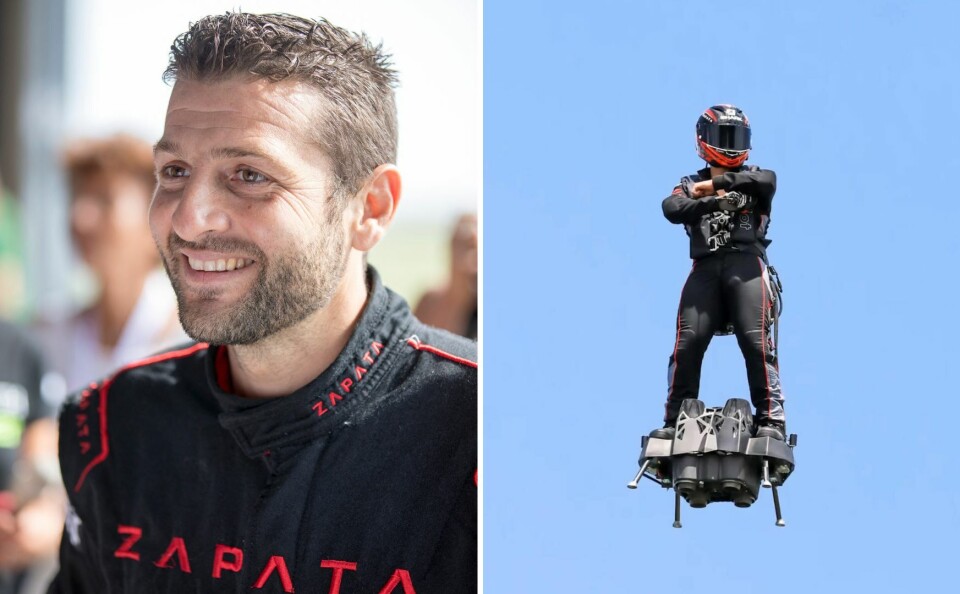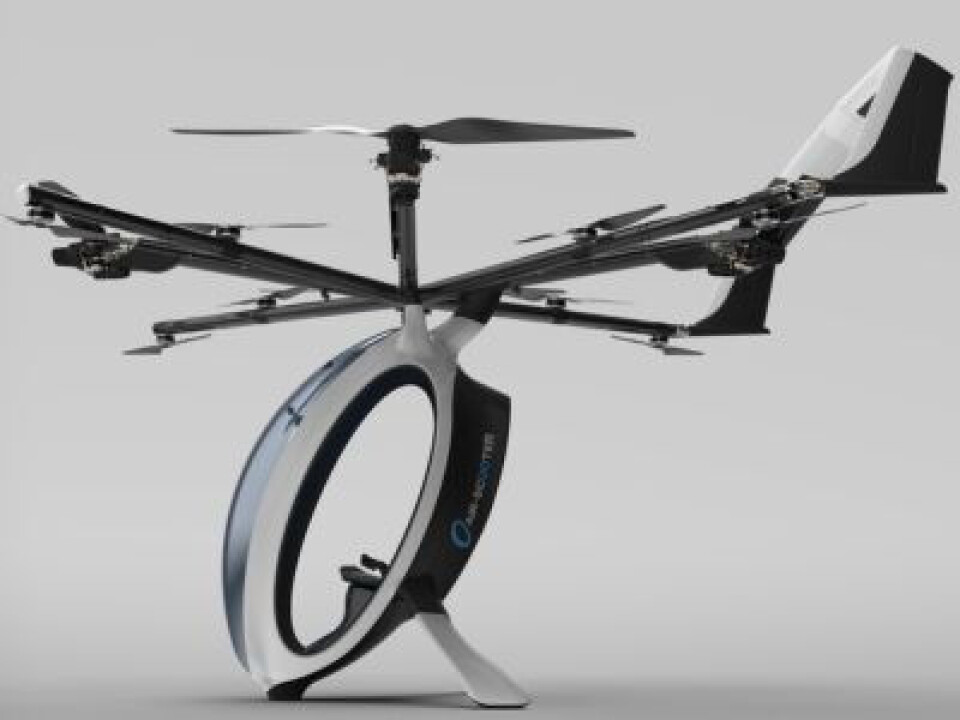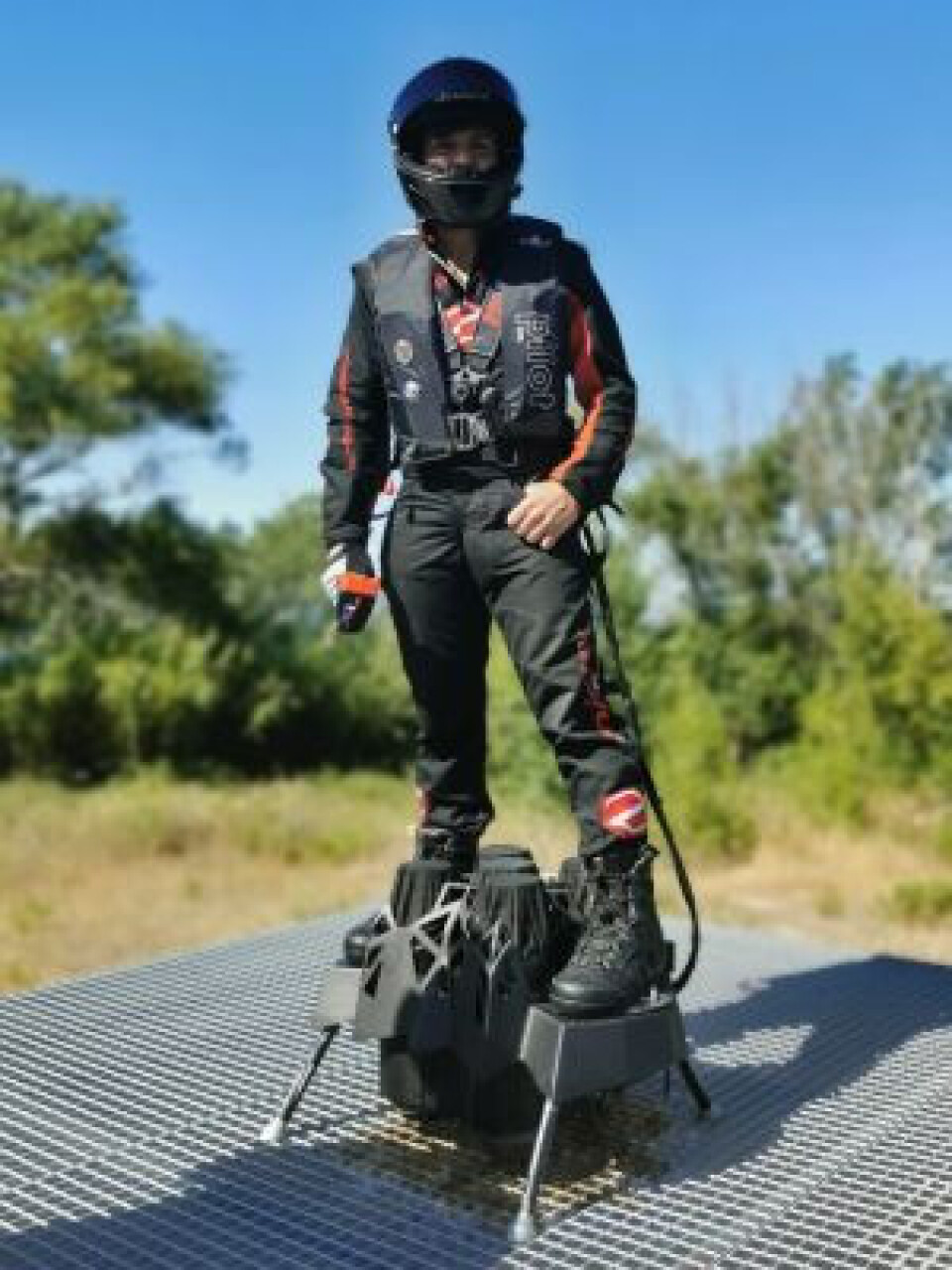-
From English teacher to TikTok star in France: 'The way to help students learn is to believe in them'
Toulouse-based Monsieur Prof's educational videos on learning English are a social media sensation
-
‘The first baby hedgehog we rescued was love-at-first-sight’
We speak to an expert about her hedgehog health centre and how to make your garden more hedgehog-friendly
-
Ballet lessons bring health benefits to over-55s in France
Online classes with the Silver Swans are transforming lives of older adults
France’s ‘Iron man’: ‘I had this crazy dream of flying even higher’
He tells us how hard it is to fly and why he keeps inventing despite French bureaucracy and nosy neighbours

In July 2023, Franky Zapata introduced AirScooter, his most recent invention, as “a machine destined to make people’s dreams come true, by allowing them to fly”.
Among the dreamers is a man who, from his early childhood, was inspired by The Rocketeer, a comic book about Cliff Secord, who wears a rocket on his back.
French people were first introduced to Mr Zapata through the Flyboard, an earlier invention that was fastened to his feet, and connected by a long hose to a watercraft that provided sufficient thrust to allow the wearer to fly many metres above the ground.
He burst onto the international scene after successfully crossing the English Channel, on his second try, in 2019.
He had previously demonstrated his flying abilities to President Emmanuel Macron during that year’s Bastille Day festivities.
But the path of the ‘flying man’ (as French people call him) has not always been smooth.
“When I first thought about flying, I did not think about it in aviation terms. I just took the word at face value. The word ‘fly’ now comes into conflict with the regulations,” Mr Zapata said in an interview with The Connexion.
His story may ring true with readers dealing with immigration officials and France’s complicated, cumbersome, and notorious bureaucracy that can shatter so many dreams.
His entrepreneurial journey also reinforces a recurrent trope about attitudes in France, when he shared a story about how one of his neighbours had him questioned by the police.
Luckily for future AirScooter users, the ‘French Iron Man,’ as he is also called, never let doubters get in his way.
AirScooter is currently on trial in his company’s flight centre, in Lake Havasu City, Arizona.
The first flights are scheduled for early spring 2024, most probably in the United States.
“If you tell me I cannot fly, of course, I will go to the United States. Not for revenge, not because I am bitter, but because it is my dream,” he said.

Photo: The AirScooter, currently in trials, is a personal, lightweight ‘aircraft’, just over two and a half metres tall. The user sits is the oval opening; Credit: Zapata/AirScooter
What is it like to fly? Tell us how it feels to be in the air
It is not easy to describe. The main thing to understand is that it does not feel as it looks from the ground. It looks calm and easy enough, but it is the exact opposite.
You need a lot of physical skill and endurance. I am constantly fighting against turbulence, mainly from the wind.
It is not at all peaceful. Picture it like skiing down a bumpy piste with your brain thinking ahead really quickly and your legs and abdominals burning.
So, it is far from being a relaxing or contemplative experience
Far, far from it. Flights are usually very technical and you constantly need to take the wind and mechanical problems into consideration.
I specifically choose to fly under stressful conditions, when it is very windy, to keep myself in good shape and to stay competitive.
I have been doing competitive sport since I was six, and have had a 16-year career in motorboat racing. I need to train around six to eight times a week just to be able to fly for two hours.
Is the ability to fly the greatest dream for all humans?
It is mine, and the business model I developed is based on that idea.
Flying is the final step for man towards freedom, a liberation from the boundaries of being human.
Unfortunately, in many countries the air does not belong to us but to the government. I have learned this over the years, although I believed the opposite when I started this business.
After you ripped the skin off two fingers on your first try and crashed into the wall of your house, what made you continue to pursue your dream?
I was very lucky because the skin grew back. But I have done many more dangerous things in the past in my sporting career. I am used to this kind of danger.
However, it is true that this incident forced me to ask myself serious questions.
At the start, turning my passion into a viable business was very hard. My wife and I were alone. When we started earning a living from water flyboarding, our dream started to come true. But I had this crazy dream of flying even higher.
When I ripped the skin off my fingers on my first flight, my wife said: “When is it ever going to be enough?”
I spent four or five months telling myself she was right, until one morning I felt the opposite, and promised her I would be more careful. I am grateful she trusts me. This adventure is a collective journey.
The gendarmes did not see an inventor but a delinquent. How did your Flyboard get you arrested in 2017?
It all started because of a neighbour who complained about the noise from my machine and who, in typical French fashion, out of spite or jealousy, made it her life mission to get me in trouble with the police.
It went all the way to the prosecutor who, for some reason on that day had nothing better to do than to call me and order the gendarmes to come and take me for questioning.
I do not know if that police officer saw a delinquent, but with the Flyboard, I was technically flying, as it was connected to a hose that propelled me into the sky.

Photo: Franky Zapata on a Flyboard; Credit: Franky Zapata
Did you ever think about moving to the United States?
No. It will take more than that to break me. I do not hold a grudge. In a sense, I understand that neighbour. It is just sad that she needs that goal in her life.
Luckily, French civil aviation found a solution. If there is a light at the end of the tunnel, then I am prepared to put myself fully into a project.
If it is all for nothing, and you tell me I cannot fly, of course I will go to the United States. Not for revenge, not because I am bitter, but because it is my dream.
Many people working in civil aviation saw me as an innovator, even though I do not think of myself as one, and I have made it possible to realise my dreams.
Read more: What are the rules for using drones in France?
Is it frustrating to be an inventor, innovator, or entrepreneur in France?
Not really, no. I am just someone having fun with his friends and doing everything I can to fulfil my passion.
Money starts to matter if you want to move on with your project once the machine is made.
It is the most important tool in your toolbox. But at the same time, it is incredible to turn an idea into a great commercial experiment.
Being an entrepreneur in France, you come up against open doors and closed doors, that is just how it is.
If one door closes in France, another opens in the United States. It does not matter where.
I love France but I feel like I am a citizen of the world. If we have to move production to India, I will do it. If we have to move our operating systems to the United States, we will go there. The world belongs to everyone.
When you first tried to cross the Channel and failed, what made you think you could succeed on the second attempt? Confidence in yourself or your machine?
I was not sure at all that I would make it. It was inconceivable to stop after I had failed.
People were impressed by the fact that I attempted another crossing right from the get-go. In my mind, it was obvious that I was going to do it again.
The main thing I’ve learned over my career is that you have to be fairly modest when it comes to success.
There is a huge gap between perceived and real value. And success happens often randomly. You can be proud of what you have achieved, but sometimes people do not see how difficult it was.
The idea of flying across the English Channel was crazy to most people but not to me.
I knew the Flyboard could fly. I knew it had the right amount of battery power, and the margin to cross was extremely tight but doable.
It required a lot of physicality and time, but I felt ready. It is one of the greatest victories of my life.
What does the future hold for your Flyboard and JetRacer? I read that you are planning to launch an AirScooter next year…
It became too complicated to transmit my passion for flying with the Flyboard. This is why I created the JetRacer, which has a longer production cycle. AirScooter came out at around the same time.
After I crossed the Channel, there was a negative campaign about the carbon footprint of our machines linked to the fight against global warming. JetRacer does indeed use a huge amount of carbon.
The project was put aside to focus on AirScooter, which uses less fuel per hour than JetRacer consumes in a minute.
I tested AirScooter on the Mediterranean coast, and you get a completely different view of the world. Hopefully, clients will be able to fly recreationally at 3,000 metres. It will be in circulation around spring 2024.
Our machines are still at the prototype stage but it is coming soon. Maybe it will just be fun. Maybe it is a new step towards a new form of transport. We shall see.
Read more: Flying ‘drone taxis’ on track to carry passengers at Paris Olympics
Your first tests took place in Arizona. Why?
I live part time in Lake Havasu City because it is where most of the water sports world championships were held when I was competing. It is a second home and many of my friends have settled there. We plan to open our first Fly centre there.
For the moment, the machine flies without passengers. In a few weeks time, we’ll be able to climb aboard.
We’ll be doing Route 66 to show that we have the autonomy and reliability we claim. If it works there, it should work in 50,000 American cities.
The South China Morning Post compared you to Daredevil. The Daily Mail to Iron Man, others to Aladdin. You said your childhood reference was Rocketeer. Which do you prefer?
If I had to choose one, I would rather be Iron Man. This is who really inspired me.
Yes, Rocketeer inspired me immensely. But behind Iron Man lies Tony Stark. He is the passionate man behind the development and the engineering of Iron Man.
Flying is the icing on the cake. Before that, there are thousands of hours of work and research.
Related articles
Insoles with reversible aircon is latest from French serial inventor
Wheelchair brakes win top prize at France’s invention competition
Toothbrush reinvented by French entrepreneurs to clean in five seconds
























